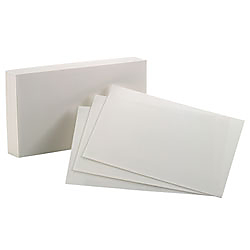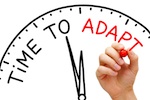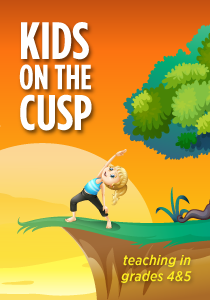Shuffling the Curriculum
 A MiddleWeb Blog
A MiddleWeb Blog
If you’d asked me 15 years ago what my greatest challenge was as a teacher, I would have answered, “Time.” There was never enough of it. At the beginning of my first year, I had no clue as to how much curriculum there actually was. I’d never taken a look at the big picture.
Index Cards became one of the most important tools I used to address time management and curriculum content as a new teacher. Blank, white index cards showed me the enormity of my task.
One particular set of index cards gave me a moment of clarity, blended with a sprinkle of self-doubt, as I sat in my first year classroom, fade-resistant bulletin board paper hanging by the chalkboard with care. I had been at school since mid-August, my excitement and fear growing, when these simple index cards came into play.
My mentor teacher was responsible for showing me the ropes. When I met with her to go over the year’s curriculum, she said I needed to get a snapshot of all there was to cover over the course of the next ten months. We sat down with index cards and a set of colored magic markers.

Our Social Studies cards were labeled as, “Map Skills, Government of New Jersey, New Jersey, Land and Water Forms, and Regions of the United States.” They were written in blue.
The four themes in our quarterly reading program were written in magenta, and the 10 units of math were added in dark purple. On the last 10 index cards she wrote the months, September through June, and laid them out as column headers. She had a wicked grin on her face and a twinkle in her eye.
It was time to stand back. The math was easy. Ten months. Ten cards. The other subjects were spread out as evenly as possible amongst our year-at-a-glance.
It was quite a glance. It was overwhelming. It was the first time I truly saw, lying on the carpet in front of me, how much there was to teach. I remember thinking that there would never be enough time to teach it all. I didn’t know how right I was.
By early October, I was already noticeably behind in my index card plan, but the kids were learning in spite of my inability to keep up. I spent that year, and the next several years, teaching children, subject by subject, desperately trying to fit it all in. I never did.
Integrate or perish
In order to effectively give my students the tools they need, I need to integrate subjects across the curriculum. This is not a new idea. The curriculum continues to grow and change. The subjects are far greater in number than the four, color-coded curriculum topics I met years ago.
There are new standards – within states and across the nation – standards attempting to identify foundational skills that our students need to help them be successful academically, socially, and emotionally. No Critical Skill Left Behind.
Social Studies, Science, and Literacy Standards share many of the same innate goals. National science standards “recommend the use of history in school science programs to clarify different aspects of scientific inquiry, the human aspects of science, and the role that science has played in the development of various cultures” (taken directly from http://www.nsta.org)
The Social Studies Standards challenge us to help kids “acquire the knowledge and skills to think analytically and systematically about how past and present interactions of people, cultures, and the environment shape the American heritage and affect issues across time and cultures.” (taken from www.njcccs.org)

This program gave me the opportunity to use rich literature across genres and expose my students to a variety of writing approaches and techniques. Social Studies and Science topics are often the focus of my “Language Arts” lessons. Planning my lessons with a broader view of curriculum in mind is helping me accomplish this with greater ease.
We finished our first year applying this new philosophy, as we also attempted to incorporate the new national CCSS ELA-Literacy goals into the teaching of reading and writing. It was a bit daunting at times, as incorporating anything new can be, but I like it. The kids like it. It’s refreshing for all of us.
I saw their critical thinking skills develop quickly, in a different, cross-curricular kinda’ way. CCSS ELA-Literacy Standard RI.4.3 asks students to “Explain events, procedures, ideas, or concepts in a historical, scientific, or technical text, including what happened and why.” Broad and deep.
Education and teaching practices are changing because standards are being developed on a broader level. A more topic-oriented curriculum is being replaced with a standards-driven set of core skills and understandings that our kids need.
People are working hard to develop meaningful curriculum, but, for a while, it didn’t seem like any of the individual curriculum departments were working together, to co-mingle topics in an attempt to integrate shared learning goals. This never made sense to me.
This past June, we had a district-wide grade level meeting, our last one of the school year. The Social Studies supervisor who facilitated it told us about a new district-wide goal: we will work together to develop a mutual curriculum, a curriculum to combine learning goals in literacy and the social sciences. I’m looking forward to seeing where this leads.
Laying out the cards in new ways
If you ask me today what my greatest challenge is as a teacher, lack of sufficient time still holds a stubborn spot at the top of the list. The index card lesson still resonates with me, but today I know it’s not about getting through a curriculum.

I haven’t used it as a tool for myself in many years. It might be a good exercise to try again when this new school year begins. I am a tactile and visual learner, like many of my students.
Being able to shuffle the cards, to rearrange them, to mix and match topics of interest to my students, rather than treating each subject as a separate entity, is eye-opening. It is a way to help my students see and explore the bigger picture. Some plain, white index cards helped me see it too….
































